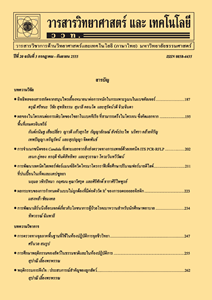ผลการให้กระเจี๊ยบแดงในน้ำดื่มต่อการสมรรถภาพการผลิต ค่าโลหิตวิทยา และไขมันในเลือดของไก่เนื้อในสภาพการเลี้ยงหนาแน่น
Main Article Content
Abstract
Abstract
The objective of the experiment was to investigate effects of roselle (Hibiscus sabdariffa Linn.) in drinking water on production, haematological parameter and blood lipid profile of broilers under high stocking density. A total of 128 broiler chicks (Cobb-500) was arranged in 2 x 2 factorial in completely randomized design with two levels of stocking density (6 and 10 birds/cage) and roselle in drinking water (0 and 4 g/L) with 4 replications. The results showed that body weight, weight gain and average daily gain were significantly different (p < 0.05). Feed intake, feed conversion ratio, haematological parameters and blood lipid profiles were not significantly different (p > 0.05). The results of the experiment concluded that roselle in drinking water is beneficial effects on poultry production to improve production performance.
Keywords: production; haematological parameter; blood lipid profile; high stocking density
Article Details
References
[2] Sohail, S.S., Bryant, M.M. and Roland, D.A., 2004, Effect of reducing cage density on performance and economics of second-cycle (ForceRested) commercial Leghorns, J. Appl. Poult. Res. 13: 401-405.
[3] Manoli, L.P., Henricks, G.L. and Kalama, M.A., 2004, Effect of chronic variate species and on total radical trapping potential in distinct regions of rat brain, Neurochem. Res. 25: 915-921.
[4] Frankel, A.I., 1970, Symposium: Recent Advances in Avian Endocrinology, Poult. Sci. 49: 869-892.
[5] Tankson, J.D., Vizzier-Thaxton, Y., Thaxton, J.P., May, J.D. and Cameron, J.A., 2001, Stress and nutritional quality of broilers, Poult. Sci. 80: 1384-1389.
[6] Richard, J.J., 1998, Physiological manage ment and environmental triggers of the ascites syndrome, Poult. Int. Asia Pacific Edition 37: 28-33.
[7] Harmon, B.G., 1998, Avian heterophils in inflammation and disease resistance, Poult. Sci. 77: 972-977.
[8] Jain, N.C., 1993, Essential of Veterinary Hematology, Lea & Febiger, Philadelphia, 417 p.
[9] Gross, W.B. and Seigel H.S., 1983, Evaluation of the heterophil/lymphocyte ratio as a measure of stress in chicken, Avian Dis. 27: 972-979.
[10] Farhadi, D. and Hosseini S.M., 2016, Evaluation of growth performance, carcass characteristics, litter quality and foot lesions of broilers reared under high stocking densities, Iran J. Appl. Anim. Sci. 6:187-194.
[11] Barton, M.D., 2000, Antibiotic use in animal feed and its impact on human health, Nutr. Res. Rev. 13: 279-299.
[12] Chopra, I. and Roberts, M., 2001, Tetracycline antibiotics: Mode of action, applications, molecular biology and epidemiology of bacterial resistance, Microbiol. Mol. Biol. Rev. 65: 260-323.
[13] ทัศนีย์ อภิชาติสรางกูร, 2540, สุขศาสตร์สัตว์, สารพัดพิมพ์, เชียงใหม่, 297 น.
[14] Cogliani, C., Goossens, H. And Greko, C., 2011, Restricting antimicrobial use in food animals: Lessons from Europe, Microbe 6: 274-279.
[15] Liu, G.M., Wei, Y., Wang, Z.S., Wu, D., Zhou, A.G., and Liu, G.L., 2008, Effects of herbal extract supplementation on growth performance and insulin-like growth factor (IGF)-I system in finishing pigs, J. Anim. Feed Sci. 17: 538-547.
[16] รังสรรค์ แตงโสภา, วีระวุฒิ พรมดี, สาธิต บุญอาจ, มานะ สุภาดี, วิศิษย์ เกตุปัญญาพงศ์ และกุลิสรา มรุปัณฑ์ธร, 2554, ผลของสมุนไพรเบญจกูลและขิงต่อค่าทางโลหิตวิทยาและจํานวนจุลินทรีย์ในไก่เนื้อ, แก่นเกษตร 39(ฉบับพิเศษ): 251-255.
[17] Mohamed, B.B., Sulaiman, A.A. and Dahab, A.A., 2012, Roselle (Hibiscus sabdariffa L.) in Sudan, cultivation and their uses, Bull. Environ. Pharmacol. Life Sci. 1: 48-54.
[18] โรงพยาบาลธรรมศาสตร์เฉลิมพระเกียรติ มหาวิทยาลัยธรรมศาสตร์, กระเจี๊ยบแดง, แหล่งที่มา : http://www.vchar karn.com/varticle/39615, 15 มีนาคม 2559.
[19] Da-Costa-Rocha, I., Bonnlaender, B., Sievers, H., Pischel, I. and Heinrich, M., 2014, Hibiscus sabdariffa L. – A phytochemical and pharmacological review, Food chem. 165: 424-443.
[20] Awodola, P.O., Ajibiye A.A. and Longe O.G., 2015, Effect of graded livels of Roselle (Hibiscus sabdariffa Linn.) calyx extract on performance and carcass characteristic of broiler chickens, Int. J. Poult. Sci. 14: 343-347.
[21] วิศิษย์ เกตุปัญญาพงศ์, อับดุลรอฮิม เปาะอีแต และฮานีย๊ะ เปาะเย๊าะ, 2551, การเจริญเติบโตและคุณภาพซากของนกกระทาญี่ป่นที่กินอาหารเสริมกากกระเจี๊ยบแดง, ว.มหาวิทยาลัยราชภัฏยะลา 3(2): 97-105.
[22] นาม ศิริเสถียร, 2531, เมล็ดกระเจี๊ยบแดงหมูกินได้ไหม (การใช้เมล็ดกระเจี๊ยบแดงเป็นอาหารสุกรรุ่น-ขุน), ว.สุกรสาส์น 15(58): 5-16.
[23] Kahkonen, M.P., Heinonen, M., 2003, Antioxidant activity of anthocyanins and their aglycons, J. Agric. Food Chem. 51: 628-633.
[24] Miguel, M.G., 2011, Anthocyanins: Antioxidant and/or anti-inflammatory activities, J. Appl. Pharm. Sci. 1(6): 7-15.
[25] Marinho, M.C., Lordelo, M.M., Cunha, L.F. and Freire, J.P.B., 2007, Microbial activity in the gut of piglets: Effect of prebiotic and probiotic supplementation, Livest. Sci. 108: 236-239.
[26] Hansen, C.F., Riis, A.L., Bresson S., Hojbjerg, O. and Jensen, B.B., 2007, Feeding organic acids enhances the barrier function against pathogenic bacteria of the piglet stomach, Livest. Sci. 108: 206-209.
[27] Ogunwole, O.A., Abu, O.A. and Adepoju, I.A., 2011, Performance and carcass characteristics of broiler finishers fed acidifier based diets, Pak. J. Nutr. 10: 631-636.


